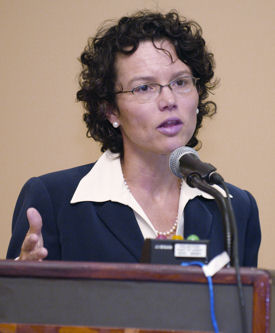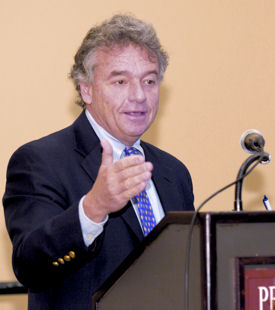Predicting risk is next challenge in tackling breast cancer
Declining mortality from breast cancer creates a new problem. How will internists decide which patients will benefit from the new treatment and prevention strategies? Also, get an advance look what will influence the next 10 years of treatment.
Improvements in breast cancer prevention and screening have led to declining mortality rates over the last 30 years but the welcome progress has brought new challenges for internists. How do physicians decide which patients would most benefit from which new prevention and treatment strategies?
“We have many new tools now, but it's hard to figure out who should use them,” said Katrina Armstrong, FACP, who led a session at Internal Medicine 2009 on breast cancer prevention and screening. “Over the next 10 years, I expect to see substantial changes in the area of risk prediction.”

Currently, there are three major ways to predict risk: identification of major risk factors such as BRCA1 and 2 mutations, family history-based models, and the “old standby” Gail model, said Dr. Armstrong, associate professor of general internal medicine at the University of Pennsylvania. Family history is the best indicator of risk, she said, but it is time-consuming and often not practical at the point of care. And getting an accurate picture of genetic risk is complicated by the confusing array of tools currently available on the Web and the difficulty of assessing their validity in the absence of federal regulations, she added.
Advances in chemoprevention using the selective estrogen receptor modulators tamoxifen (Nolvadex) and raloxifene (Evista) have successfully prevented or delayed some cancers in high-risk women, Dr. Armstrong explained. However, tamoxifen has multiple side effects, including endometrial cancer, deep venous thrombosis and cataracts. Raloxifene has fewer, but still significant, side effects, such as increased risk of stroke.
“We have two imperfect drugs that we know can prevent breast cancer, but there are tradeoffs,” said Dr. Armstrong. “The likelihood of benefit increases as a woman's risk of breast cancer increases,” she added. Level of risk and patient preferences should factor heavily into a woman's decision to choose chemoprevention.
In the area of screening, magnetic resonance imaging (MRI) has become an important tool in detecting cancers in high-risk women, she said, and the American Cancer Society recommends it for women with an approximately 20% to 25% or greater lifetime risk of breast cancer. However, while MRI screening has greater sensitivity, there is no evidence to date that it leads to decreased mortality.
Dr. Armstrong listed these four major risk factors, any one of which would classify a woman as at high risk for breast cancer: BRCA1 or 2 mutation; prior chest irradiation (such as for Hodgkin's disease); lobular carcinoma in situ (LCIS) or ductal carcinoma in situ (DCIS); and certain rare genetic disorders such as Cowden or Li-Fraumeni syndromes.
Cost and access are often major obstacles to implementing appropriate interventions, said Dr. Armstrong. BRCA testing, screening MRI and chemoprevention carry hefty price tags that often must be borne by patients. In addition, availability of interventions varies geographically, with more options available to women in major metropolitan areas than in rural areas.
“We can do all these studies on disparities but it often comes down to price, and the costs are not trivial,” she said. “We can't move to using new technologies unless we can determine if the costs can be reduced to improve access.”





